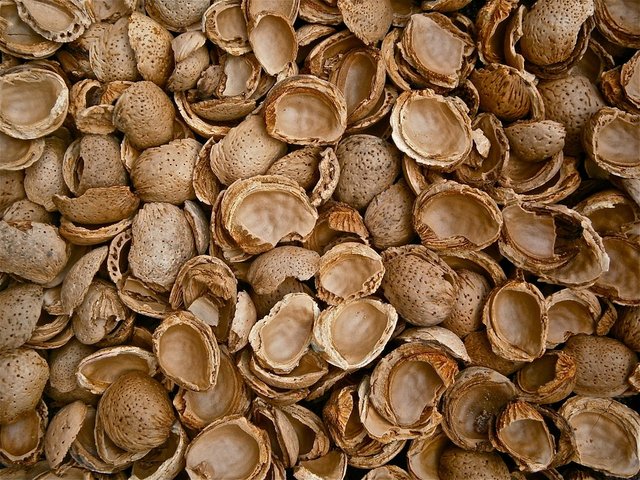THE URBAN FORAGING HANDBOOK: ALMONDS for ThursdayGreen ColorChallenge
Welcome to the Urban Foraging Handbook.
Believe it or not, there is free food growing just up the street from you. You only need to know where to look. I will focus on the foods that grow in most areas of the world, aside from the extremes of hot and cold, so that you have the likeliest chance of finding the plant in your area. The ColorChallenge initiated by @kalemandra focuses on the color green for every Thursday and what better way to celebrate this color than by examining the lush, growing, GREEN food that exists all around us.
So, for this week we will focus on the supernut, ALMOND!
 Source
SourceThe almond harvest is definitely in full swing, so the time for foraging almonds is drawing near. If you live in an area where almond farming is common (actually, this is a good tip for any farming area, unless you want to jump in and help and then you can get paid in produce) then courtesy dictates that you wait until the field is done before you go in to forage. The farmers will always leave a good bit of produce in the field and anyone can then come in and pick.
Almonds are ready to harvest
When the green outer casings begin to split, turn brown, and fall off. Almonds have two outer casings before you get to the nut. The thick green skin of the outermost layer will keep the almond warm and insulated in the early months of spring and summer. Towards the end of summer the green skin will dry out and fall off, revealing the hard brown nut that we are used to. Inside the hard shell is the oval nut meat that is edible. The almonds are still “green” in the inside of the shell and can be eaten in a multitude of ways.
 Source
SourceRaw almonds
Raw almonds are perfectly safe to eat, although eating more than a few handfuls at a time can cause a stomach ache, as almonds are fairly high in natural oils and fats. They can be eaten straight out the shell, or bagged for eating later. They are a great long energy food for trail mix and are on my list as a survival food.
Cooked almonds
Since almonds are high in protein as well as fats they make a good addition to vegan, vegetarian and low meat dishes that will both fill you up and give you the energy and nutrients you need. You can find recipes from all over the world that use almonds in pastes, salsas, sauces, soups and entrees. My personal favorite way if eating almonds comes from my mother who used to roast them in a pan with a little oil, salt, white pepper, and garlic.
Almond oil
Almond oil can be pressed from raw almonds almost as soon as they are harvested. Almonds have a high concentration of oil in them and the oil is very beneficial. The oil can be eaten, cooked with, rubbed into the skin and hair and is even good for your pets, in small doses. What to do with the almond paste that is left? Well, make…
Almond flour
Flour can be made from ground up almonds that have been left to dry. The paste that is left after pressing oil can also be used, and in fact makes a lighter four, although there are less nutrients. Full almond flour can be quite dense, so if you want to make something light and fluffy, i.e. cake, I highly recommend that you cut the almond flour with a lighter floor, i.e. wheat or rice.
 Source
SourceTo harvest almonds from an almond tree:
The easiest, and perhaps most authentic, way to harvest an almond field is to lay large tarps on the ground under a tree, and then take a long pole and beat the almonds it off the branches. No joke. Whack them nuts right out of the tree.
Note: Most almond trees will be severely cut back for the winter, so you don't have to worry about damaging the trees with the pole, all of those branches will get cut back close to the trunk.
The tarp will catch what falls and you can just pick up the tarps and move on to the next tree. When the tarps fill dump them into large sacks or buckets to sort, clean and store.
Note:Almonds will keep longer in the shell, so only crack open as many as you want to eat immediately and/or cook with. Store the shells in sacks or buckets in a dark, cool place. Garages, pantries, and back rooms are ideal.
Once the almonds have been collected they will need to be dried. Just lay them out in an open area to either dry in the direct sun or to sit out in a well ventilated location. Again, garages, back rooms, bottom floor entryways… the street in front of your house, you know, wherever ;)
Oh, and did I mention that eating a handful of almonds is like taking a Prozac? They are nature's little happy drug ;)
 Source
SourceAs always, for anything wild that you decide to eat I recommend that you take a piece and rub a small part of your inner forearm with the "sap" that appears when the plant is broken open. All of these plants are edible, but you never know what kind of reaction you may have to a new food. If your arm swells and itches, chances are that your mouth will do the same and your stomach will upset.
Well, I hope you all go out and at least look at the weeds differently!
If this information was helpful or interesting to you, please upvote and repost so that we can reach as many people as possible. Ignorance breeds hunger and when there is so much natural food to be eaten in nature it seems a shame that people go hungry.
Did our ancestors go to the grocery store? I think not!
Until next time my friends,
@jennswall
website, twitter, facebook

Do not steal, re-use, copy or distribute this image without my consent.
(Re-steeming is fine.)
(Upvoting is also ok)




He he, there is definitely not an almond growing up the street from me! Nice post, thanks.
No? No almonds in your area? I must admit this is the first time I've lived in an almond climate myself ;)
There are castanhã do Maranhão (I'd have to check up the latin name for that for you) growing in my front yard here in Paraty, RJ, Brazil, which are quite cool. Very sweet.
Do you pronounce the "l" in your almonds? Is it still an almond if you do?
Hmmm...I do believe that I pronounce the "l" in "almond"...I'd never really listened before, lol. And yeah, I think an almond will still be an almond regardless of how we decide to pronounce it's name. Do you eat the "hazelnuts" from your castanha tree?